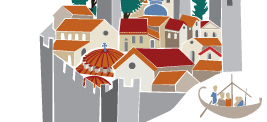Communications
In Late Antiquity
and in Byzantium travelling simply for pleasure was unheard of; journeys always
had a purpose, and depended on the time of year, means of transport, time,
place and travelers’ financial means. During Late Antiquity, when the Byzantine
Empire was very strong in both land and sea, travel destinations were not
limited to the Mediterranean but extended eastwards as far as China, India and
Ceylon, south to Ethiopia and north to the Black Sea. However, after the 7th
century, despite the sporadic mention of some journeys to exotic places, people
rarely traveled except on special missions organized to foreign countries, such
as the mission to Moravia in Central Europe undertaken by brothers Cyril and
Methodius . In late Byzantium Emperor Manuel II Palaeologus
. In late Byzantium Emperor Manuel II Palaeologus and his close
associates got as far as England, while a daring and adventurous trader named
Lascaris Cananus reached Scandinavia, the Baltic countries and Iceland.
and his close
associates got as far as England, while a daring and adventurous trader named
Lascaris Cananus reached Scandinavia, the Baltic countries and Iceland.
Land and sea journeys were often made by traders. Just as frequent were the movements of
sailors, soldiers and diplomats or government officials on special missions. Yet travels for religious purposes were the
most common: as early as the 4th century many pilgrims left the far reaches of
the empire for Rome and the Holy
Land, while Constantinople was the most famed destination, arousing the interest of
Byzantines and foreigners throughout the Middles Ages.
Journeys for educational or cultural purposes
were less frequent in the early centuries. One special category consisted of journeys made by clerics of all ranks,
who went on pilgrimages or in search of a place for spiritual contemplation.
Sea travel was preferred due to greater speed. There were no passenger
ships operating regular services to specific locations. Those wishing to travel
headed for a port and either found a ship to take them where they wanted, if
they could afford to charter it for their own convenience. The fare depended both on the distance covered
and on the captain’s demands, so unwary travellers could be tricked into paying
more.
Ship type and
weather conditions determined how long journeys took; the average distance
covered within a day could vary from 30 to 50 kilometres though there were
faster ships.
On land routes travellers usually went on foot, as they seldom had mules,
donkeys or camels which were mainly used to carry large loads. Carts were even
rarer, and horses and carriages were reserved for army officers and officials
on state business.
Travelling involved many risks. On board ship there was always the
threat of rough seas and shipwreck, and the ever-present danger of travellers
falling victim to piracy and taken prisoner. Those on land were at risk from
thieves and crooks lurking on public roads for their victims, so people usually
travelled in groups to protect each other. A local guide familiar with the area
being crossed was considered essential, especially if it had a bad reputation.
Bibliography (0)▼
Comments (0)▼
New Comment▼






